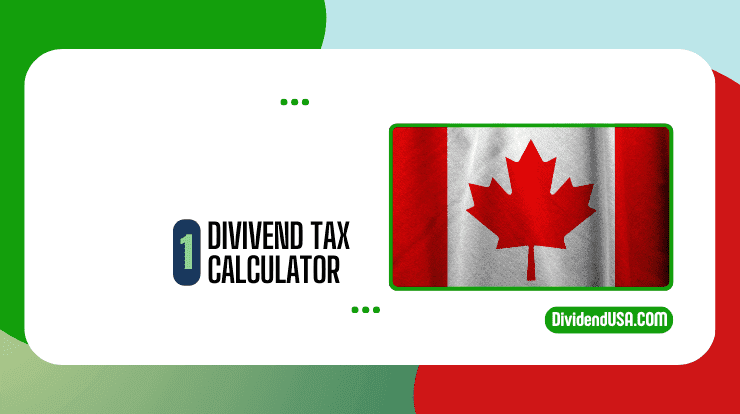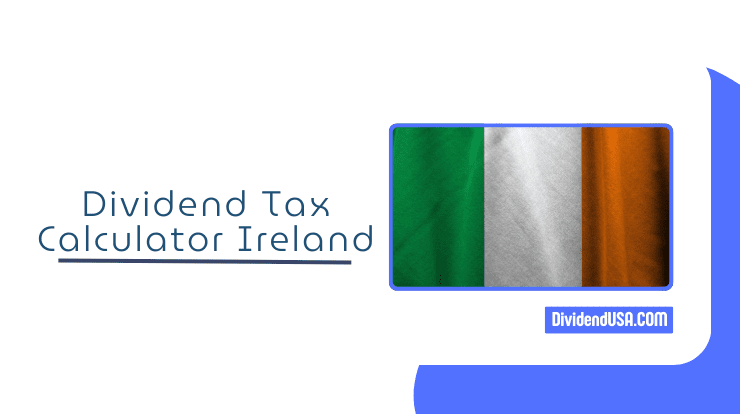Join WhatsApp Group
Join NowDividend Tax Calculator (Canada)
Input Details
Results
Dividend income in Canada refers to the payments you receive as a shareholder from Canadian corporations distributing their profits. These can come from stocks, ETFs, or mutual funds, and they’re a popular way for investors to generate passive income. However, not all dividend income ends up in your pocket—taxes take a bite. That’s where understanding dividend taxation becomes crucial.
[You May Also Like: XEI Dividend Calculator]
Why do investors need a dividend tax calculator in Canada? Simply put, it helps you figure out your after-tax dividend income in Canada by accounting for federal and provincial taxes, gross-ups, and credits. With varying dividend tax rates across provinces and between eligible vs non-eligible dividends in Canada, manual calculations can get messy. A good dividend income tax calculator simplifies this, letting you plan better for retirement, reinvestments, or budgeting. Whether you’re a beginner dipping into TSX stocks or a seasoned investor, this tool demystifies how much you really keep. In this guide, we’ll explore how it all works, with practical tips and examples tailored for 2025.
What is a Dividend Tax Calculator in Canada?
A dividend tax calculator Canada is an online tool or spreadsheet that estimates the taxes you’ll pay on dividend income and shows your net take-home amount. It factors in Canada’s unique dividend taxation system, which includes gross-ups to reflect corporate taxes already paid and credits to avoid double taxation.
Unlike basic income tax calculators, this one is specialised for dividends. It handles the nuances of eligible vs non-eligible dividends in Canada, your marginal tax bracket, and provincial variations. For instance, it might ask for your total income to determine your tax rate, then apply the appropriate gross-up and dividend tax credit.
Popular free versions are available on sites like TaxTips.ca, Wealthsimple, or financial apps. You can even build one in Excel using formulas from the Canada Revenue Agency (CRA). The goal? To give you a clear picture of after-tax dividend income in Canada, helping you compare investments or decide between salary and dividends if you’re a business owner.
In 2025, with federal tax changes like the lowest bracket dropping to 14% effective mid-year (resulting in an effective 14.5% rate), these calculators are more valuable than ever. They ensure you’re not overestimating your income or missing out on credits.
How Dividend Tax Works in Canada
Dividend taxation in Canada is designed to integrate corporate and personal taxes, preventing double dipping. When a corporation earns profits, it pays corporate tax first. Then, when it distributes dividends, you report them on your personal return—but with adjustments.
The process starts with “grossing up” the dividend to represent the pre-corporate-tax amount. You add this grossed-up figure to your taxable income, pay tax at your marginal rate, and then claim a dividend tax credit to offset the corporate tax already paid. The net result? A lower effective tax rate on dividends compared to regular income.
Federal and provincial governments both apply this system, so your total tax depends on where you live. In 2025, federal marginal rates range from 14.5% (effective) on income up to about $55,867, up to 33% over $246,752. Provinces add their own layers, making combined rates vary widely.
This setup favours dividends over interest or salary for many, especially in lower brackets. But it gets more complex with dividend types.
Eligible vs. Non-Eligible Dividends
Eligible and non-eligible dividends differ based on the corporation’s tax rate.
- Eligible Dividends: These come from public corporations or private ones taxed at the general corporate rate (around 26-27% combined federal-provincial). They’re “eligible” for a higher gross-up and credit because the company paid more tax upfront. In 2025, the gross-up is 38%, meaning a $100 dividend becomes $138 taxable. The federal dividend tax credit is 15.0198% of the grossed-up amount (about $20.73 credit on $138).
- Non-Eligible Dividends: From small businesses qualifying for the small business deduction (taxed at lower rates, like 9-12%). Gross-up is 15%, so $100 becomes $115 taxable. Federal credit is 9.0301% of grossed-up (about $10.38 on $115).
Eligible dividends often result in lower effective taxes, sometimes even negative in low brackets, due to credits exceeding tax. Non-eligible have higher effective rates but are common from private corps. Foreign dividends don’t qualify for credits and are taxed as regular income.
Understanding eligible vs non-eligible dividends in Canada is key to using a dividend tax calculator in Canada accurately.
Dividend Tax Credit Explained
The dividend tax credit (DTC) is the magic that makes dividends tax-efficient. It’s a non-refundable credit that reduces your tax bill.
Formula for taxable amount:
Taxable Dividend = Actual Dividend × (1 + Gross-up Rate)Then, DTC:
Federal DTC = Taxable Dividend × DTC RateFor 2025:
- Eligible: Gross-up 38%, DTC rate 15.0198%
- Non-eligible: Gross-up 15%, DTC rate 9.0301%
Provinces have their own DTC rates. For example, in Ontario, eligible DTC is 10% of grossed-up, non-eligible 2.9863%-3.2863% varying by income.
You claim federal DTC on line 40425 of your return, provincial on the equivalent. If credits exceed tax, they reduce other taxes but aren’t refunded.
This system ensures integration: Corporate tax + personal tax ≈ top marginal rate on income.
How to Use a Dividend Tax Calculator (Step-by-Step Guide)
Using a dividend income tax calculator is straightforward. Here’s a step-by-step for tools like those on CRA-inspired sites or apps.
- Select Your Province: Tax varies by residency (e.g., Ontario vs. Alberta).
- Input Dividend Details: Enter the amount, type (eligible/non-eligible), and if it’s your only income or part of your total.
- Add Personal Info: Your total taxable income to find the marginal bracket.
- Run the Calculation: The tool applies gross-up, calculates tax, and subtracts credits.
- Review Results: See after-tax amount, effective rate.
- Adjust Scenarios: Test different amounts or types for planning.
Always use current 2025 rates—tools update annually.
Inputs You Need
To get precise results:
- Province/Territory: Affects provincial DTC and rates (e.g., Quebec has unique rules).
- Dividend Type: Eligible or non-eligible—check your T5 slip.
- Income Level: Your total taxable income determines your bracket (e.g., under $55k federal low rate).
- Dividend Amount: Actual received.
- Other Income: For accurate marginal rate.
- Optional: Tax Year: Ensure 2025 for updated brackets.
These ensure the dividend tax calculator Canada reflects your situation.
Outputs You Get
Typical results include:
- Grossed-Up Amount: Taxable addition.
- Tax Owing Before Credit: At your marginal rate.
- Dividend Tax Credit: Federal + provincial.
- Net Tax on Dividend: After credit.
- After-Tax Dividend Income Canada: What you keep.
- Effective Tax Rate: True rate after adjustments (often lower than marginal).
For example, outputs might show a 10% effective rate on eligible dividends in a mid-bracket.
Example Calculation for Canadian Dividends
Let’s walk through a 2025 example for a Ontario resident with $50,000 other income receiving $10,000 eligible dividends.
First, marginal bracket: Combined federal-Ontario around 29.65% for income $50k-$100k.
Gross-up: $10,000 × 1.38 = $13,800 taxable.
Tax before credit: $13,800 × 29.65% ≈ $4,092.
Federal DTC: $13,800 × 15.0198% ≈ $2,073.
Ontario DTC: $13,800 × 10% ≈ $1,380.
Total credit: $3,453.
Net tax: $4,092 – $3,453 = $639.
After-tax: $10,000 – $639 = $9,361.
Effective rate: 6.39%.
For non-eligible: Gross-up $10,000 × 1.15 = $11,500.
Tax: $11,500 × 29.65% ≈ $3,410.
Federal DTC: $11,500 × 9.0301% ≈ $1,038.
Ontario DTC: $11,500 × ~3% (approx) ≈ $345.
Net tax: ~$2,027.
After-tax: ~$7,973.
Effective: ~20.27%.
This dividend tax rate Canada example shows eligible advantage.
Benefits of Using a Dividend Tax Calculator
Why bother? Here are the perks:
- Accuracy: Avoids math errors in gross-ups/credits.
- Time-Saving: Instant results vs. manual spreadsheets.
- Planning Tool: Compare scenarios, like more dividends vs. salary.
- Provincial Insights: Highlights tax differences (e.g., Alberta’s flat 10% vs. progressive provinces).
- Optimisation: Spot if eligible dividends push you into higher brackets.
- Beginner-Friendly: Explains terms as you go.
- Free Access: Many no-cost options.
Overall, it boosts confidence in the after-tax dividend income Canada estimates.
Factors Affecting Dividend Tax in Canada
Several elements influence your dividend tax:
- Income Bracket: Higher brackets mean higher tax before credits.
- Province: See table below for 2025 combined marginal rates on eligible dividends (top bracket):
| Province | Top Marginal Rate on Eligible Dividends (%) | Top Marginal Rate on Non-Eligible Dividends (%) |
|---|---|---|
| Alberta | 34.31 | 42.30 |
| BC | 36.54 | 44.53 |
| Manitoba | 37.78 | 46.16 |
| NB | 33.51 | 43.04 |
| NL | 43.37 | 47.50 |
| NS | 42.01 | 47.78 |
| Ontario | 39.34 | 47.74 |
| PEI | 38.79 | 45.62 |
| Quebec | 40.00 | 48.02 |
| Sask | 30.33 | 39.59 |
(Data approximated from 2025 sources like Mackenzie Investments; actual varies by income.)
- Dividend Type: Eligible lower effective tax.
- Other Credits: Basic personal amount, etc., interact.
- 2025 Changes: Federal rate drop benefits low earners.
- Foreign vs. Canadian: No DTC for foreign.
- RRSP/TFSA: Tax-sheltered accounts avoid immediate tax.
Monitor these for accurate dividend income tax calculator use.
Dividend Tax vs. Capital Gains Tax (Comparison Table)
Both are investment income, but taxed differently.
| Aspect | Dividend Tax | Capital Gains Tax |
|---|---|---|
| Inclusion Rate | Gross-up 38% (eligible)/15% (non) | 50% (or 66.67% over $250k annual gain) |
| Tax Rate | Marginal on grossed-up, minus DTC | Marginal on included gain |
| Credit Available | Yes (DTC federal/provincial) | No |
| Effective Rate Example (Ontario mid-bracket) | 6-20% depending on type | 14.83% (half of 29.65%) |
| When Triggered | When paid | When asset sold |
| Advantages | Lower effective, regular income | Deferral possible, lifetime exemption |
Dividends often win for income, gains for growth. Use a dividend tax calculator in Canada to compare.
Frequently Asked Questions (FAQ)
What is the dividend tax rate in Canada for 2025?
It varies by province and type. Effective rates can be 0-40%+ after credits; see provincial table.
How does a dividend tax calculator in Canada work?
It grosses up dividends, applies your marginal rate, and subtracts credits for the after-tax amount.
What’s the difference between eligible vs non-eligible dividends in Canada?
Eligible from high-tax corps (38% gross-up), non-eligible from small biz (15% gross-up), leading to different credits.
How to calculate after-tax dividend income in Canada?
Use formula: After-tax = Dividend – (Tax on grossed-up – DTC).
Is there a free dividend income tax calculator?
Yes, on sites like TaxTips.ca or TurboTax.
Do foreign dividends qualify for DTC?
No, taxed as regular income.
Conclusion
Navigating dividend tax in Canada doesn’t have to be daunting. With a solid grasp of gross-ups, credits, and provincial differences, plus a reliable dividend tax calculator Canada, you can maximise your after-tax dividend income Canada. Whether favouring eligible dividends for lower rates or comparing to capital gains, these tools empower smarter decisions. In 2025’s evolving tax landscape, stay informed and calculate ahead—your portfolio will thank you. Start estimating today for a clearer financial future.


